50 doomiest images of 2013
2013 served up some of the most spectacular doom imagery yet, as historic flooding and wildfire events proliferated globally. Poachers continued to drive megafauna, like elephants and rhinos, to extinction, providing plenty of heartbreaking pictures. Loggers razed ever more forest habitat, slaughtering wildlife wholesale and leaving a only few traumatized survivors for us to witness in photographs. 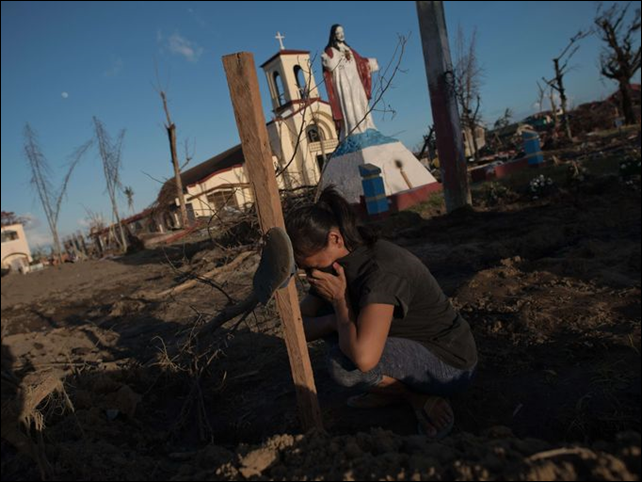 Humans continued to strip mine the oceans of all edible life, carelessly discarding tons of biomass with no commercial value. Occasionally, there’s a photo of slaughtered marine wildlife laying on a beach or piling up in a factory somewhere. And as usual, gods and religions failed to deliver salvation from record-breaking extreme weather events, so we saw more photos of religious icons gazing impassively across scenes of devastation. Check out Desdemona’s doomiest posts of previous years:
Humans continued to strip mine the oceans of all edible life, carelessly discarding tons of biomass with no commercial value. Occasionally, there’s a photo of slaughtered marine wildlife laying on a beach or piling up in a factory somewhere. And as usual, gods and religions failed to deliver salvation from record-breaking extreme weather events, so we saw more photos of religious icons gazing impassively across scenes of devastation. Check out Desdemona’s doomiest posts of previous years:

Thousands of shark fins drying in the sun cover the roof of a factory building in Hong Kong on 2 January 2013. Shark poachers have moved the shark fins to secluded rooftops instead of sidewalks – as they have done in the past – to avoid public anger. Photo: Antony Dickson / AFP / Getty Images
Outrage over Hong Kong’s ‘shark fin rooftop’ — 
Kiyoshi Kimura, president of Kiyomura Co., poses with a bluefin tuna in front of his Sushi Zanmai restaurant near Tsukiji fish market in Tokyo Saturday, 5 January 2013. The tuna sold for a record $1.76 million at a Tokyo auction Saturday, nearly three times the previous high set in 2012. Photo: Shuji Kajiyama / AP
Bluefin tuna sells for record $1.76 million in Tokyo — 
The bodies of sea lions, cormorants, and penguins were discovered on 12 May 2013 littering a seven mile stretch of beach in Punta de Choros, northern Chile. Police are investigating suspicions that the deaths were caused by local fishermen using explosives to increase catches (blast fishing). Photo: Sernapesca
More than 600 dead sea lions, cormorants, and penguins found on Chile beach, victims of Illegal blast fishing — 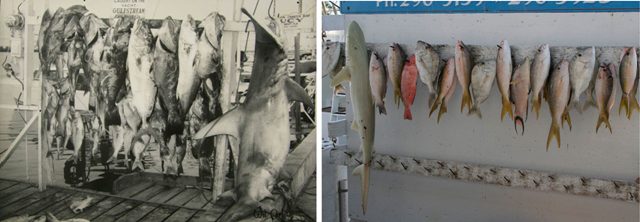
These images were taken from the same display board, from the same dock, from the same recreational fishery in Key West, Florida. The board displays the largest trophy fish that were caught that day. You can clearly see that with time, the ‘largest’ caught fish get significantly smaller and smaller. Source: McClenachan, Loren, 2009, “Documenting Loss of Large Trophy Fish from the Florida Keys with Historical Photographs”, Conservation Biology 23, 3:636-643. Photo: Loren McClenachan
Image of the Day: Landed trophy fish in Florida, 1957 and 2007 — 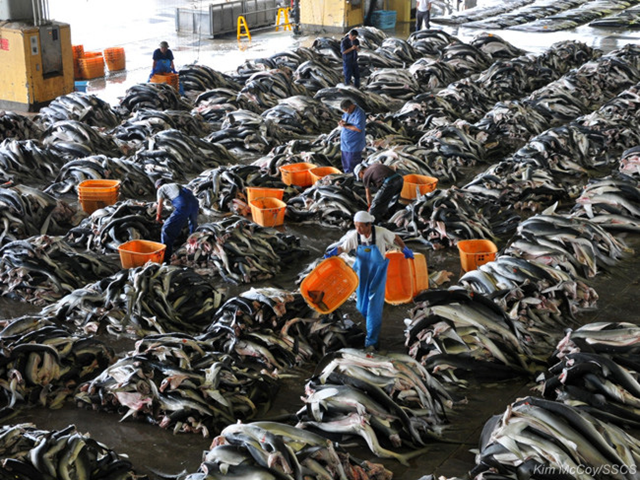
Sanriku Kakou Corporation of Japan harvests sharks on an industrial scale. Photo: Kim McCoy / Sea Shepherd
Japan to ignore fishing ban on endangered sharks – ‘We use more sharks than anyone else in the world!’ — 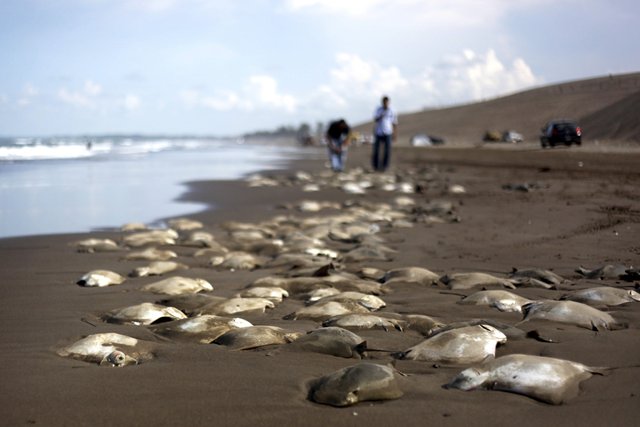
Stingray carcasses litter the shore of the Chachalacas beach near the town of Ursulo Galvan on Mexico’s Gulf Coast, Tuesday, 16 July 2013. Mexican authorities are investigating the death of at least 250 stingrays. Ursulo Galvan Mayor Martin Verdejo says witnesses told authorities fishermen dumped the stingrays on the beach because they weren’t able to get a good price for them. Chopped stingray wings are commonly served as snacks in Veracruz restaurants. Photo: Felix Marquez / AP
Fishermen dump hundreds of dead stingrays on Mexico beach – Local mayor says fishermen dumped stingrays because they couldn’t get a good price for them — 
A resident of Wuhan, China, cleared dead fish from the Fu River on Tuesday, 3 September 2013. Tests showed extremely high levels of ammonia downstream from a chemical plant. Photo: Agence France-Presse / Getty Images
Giant fish kill along 19-mile stretch of central China river caused by ammonia release from chemical plant — 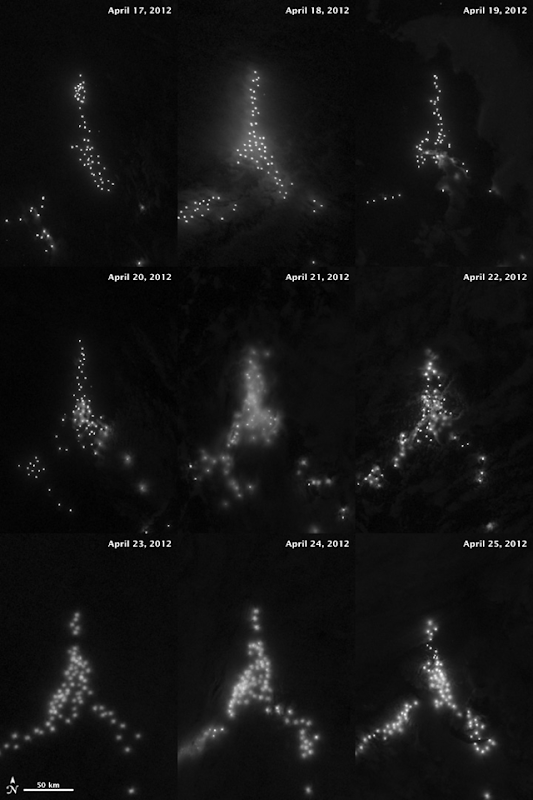
Over the course of nine nights in April 2012, illegal fishing boats shift positions while hugging the borders of the exclusive economic zones of Argentina and the Falkland Islands. Photo: NASA Earth Observatory, using VIIRS day-night band data from Suomi NPP
Image of the Day: Satellite view of squid poaching operations, April 2012 — 
Caged orangutan at Limbat’s ‘zoo’ in Kadang, Aceh on the island of Sumatra. Trade in threatened species is illegal in Indonesia, but prosecutions are rare, conservation organizations here say. As forests are increasingly cut down for plantations and mining concessions in Aceh, trafficking in wildlife is growing. Photo: Paul Hilton / mongabay.com
Illegal wildlife trade flourishes in Sumatra – Critically endangered orangutans sell for $200 – ‘It’s a zoo, but you can buy’ — 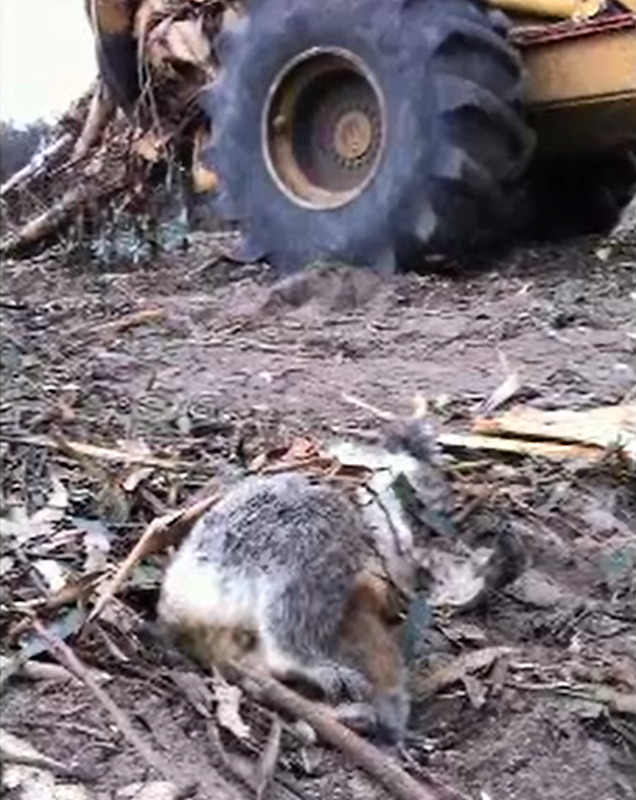
The body of a koala killed by logging operations lays in front of a logging truck, 22 July 2013. Timber workers say finding dead koalas is ‘a daily thing’, in a TV report claiming Victorian logging is wiping the animal out. Photo: Australian Broadcasting Corporation
Video of illegal gold mining operations that have turned a portion of the Amazon rainforest into a moonscape went viral on YouTube after a popular radio and TV journalist in Peru highlighted the story. Photo: Perú Ministerio del Ambiente
Video: Flyover of illegal gold mining operations destroying Amazon rainforest in Peru – ‘These are giant operations. Arsenic has been found in the Titicaca Lake.’ — 
A white rhino after it was dehorned at the ranch of John Hume, a South African entrepreneur who now owns more than 800 rhinos, with names like Curly, Titan, Hillary, and Pinocchio, and has amassed a 2,000-pound mountain of horn worth millions of dollars. Photo: Joao Silva / The New York Times
Coveting horns, ruthless smugglers’ rings put rhinos in the cross hairs — 
Three-month-old Bornean elephant calf next to dead mother. Officials suspect this elephant, and 13 others, were poisoned. Photo: Sabah Wildlife Department / Rhett A. Butler
Borneo elephants poisoned by unidentified toxin — 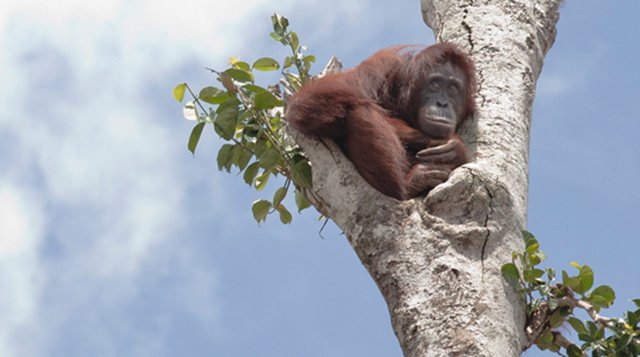
Perched atop the remains of the last tree, an orangutan looks helplessly on what was until recently the forest he was living in but is now only ruins. Armed with chainsaws and bulldozers, workers of Bumitama Gunajaya Agro (BGA), a palm oil company, have completely destroyed the rainforest for miles. This photo was taken in March 2013 during an International Animal Rescue Indonesia (IAR) rescue of four orangutans on the BGA palm oil plantation concession in West Kalimantan. Photo: IAR
Orangutans are victims of ‘sustainable’ palm oil as rainforest is razed – ‘All of the animals on the plantation are threatened. The company must therefore stop clearing the rainforest immediately.’ — 
The body of a dead elephant lies in a water hole. Poachers in Zimbabwe’s Hwange National Park have killed 81 elephants by poisoning them with the deadly chemical cyanide in the water holes the animals drink from. Photo: Uganda Picks
Poachers kill 81 Zimbabwe elephants by poisoning water holes with cyanide — 
Meluaya, a 17-year-old black rhino, was killed and dehorned by poachers at the Lewa Wildlife Conservancy, 19 November 2013. Photo: Lewa Conservancy
Poachers kill pregnant Kenya rhino in brazen attack — 
Melissa Bachman, a keen hunter who produces programs on the American outdoors, posted a photograph on Facebook and Twitter of her holding a rifle and smiling beside the corpse of a male lion, 16 November 2013. Photo: Melissa Bachman / Twitter
‘Hardcore Huntress’ Melissa Bachman smiles in photo of the lion she shot dead — 
A Tasmanian family takes refuge from record wildfires in the seawater under a jetty, 8 January 2013. Tammy Holmes (second from left) and her grandchildren, (from left) Charlotte, Esther, Liam, Matilda, and Caleb, survived the bushfires that raged for three hours. Photo: Tim Holmes / AP
Bushfires drive Tasmania family into the sea – ‘Arguably the most significant heat wave in Australia’s history’ — 
Australia’s Sydney Opera House is engulfed in a smoky haze from severe bushfires, 2 November 2013. Photo: International Business Times UK
Bushfire smoke engulfs Australia’s biggest city Sydney — 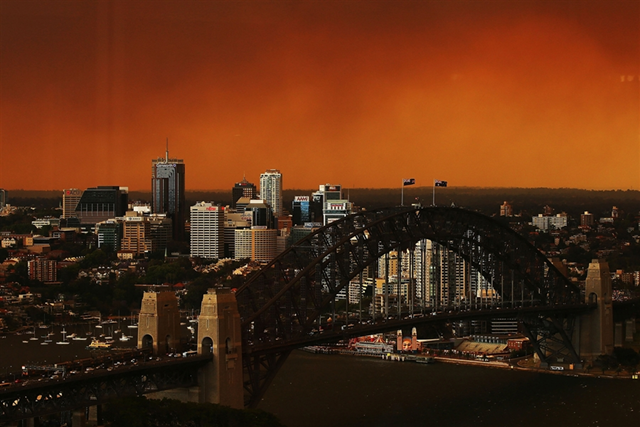
A view across Sydney Harbour Bridge and the city’s central business district on 17 October 2013. Sydney is shrouded in a haze of smoke as wildfires rage in the western suburbs of Springwood, Winmalee and Lithgow. Brendon Thorne / Getty Images
Worst bushfires in more than a decade erupt across New South Wales – Orange haze descends on Sydney as dozens of fires rage outside city — 
On the afternoon of 19 June 2013, NASA’s Terra and Aqua satellites captured this striking image of smoke billowing from illegal wildfires on the Indonesian island of Sumatra. The smoke blew east toward southern Malaysia and Singapore, and news media reported that thick clouds of haze had descended on Singapore, pushing pollution to record levels. Farmers in Sumatra often burn forests during the dry season to prepare soil for new crops. Photo: Jeff Schmaltz / NASA
Image of the Day: Satellite view of smoke from forest fires engulfing Singapore, 19 June 2013 — 
Aerial view of blackened areas that define the path of a wildfire that destroyed some homes and left others untouched in one neighborhood in the densely wooded Black Forest area northeast of Colorado Springs, Colorado, 13 June 2013. Photo: John Wark / AP Photo
Black Forest wildfire most destructive in Colorado history – 24.5 square miles burned, 39,000 people ordered to evacuate, 2 killed — 
On 4 July 2013, the Moderate Resolution Imaging Spectroradiometer (MODIS) on NASA’s Aqua satellite captured this image of wildfires burning in western Quebec near James Bay. Red outlines indicate hot spots where MODIS detected unusually warm surface temperatures associated with fire. Photo: NASA
Canada’s 2nd largest fire on record spreading smoke to Europe —
Flyby of the Yosemite Rim Fire from a National Guard firefighting plane, 23 August 2013. Photo: MAFFS
Video: Flyby of the Yosemite Rim Fire from National Guard firefighting plane — 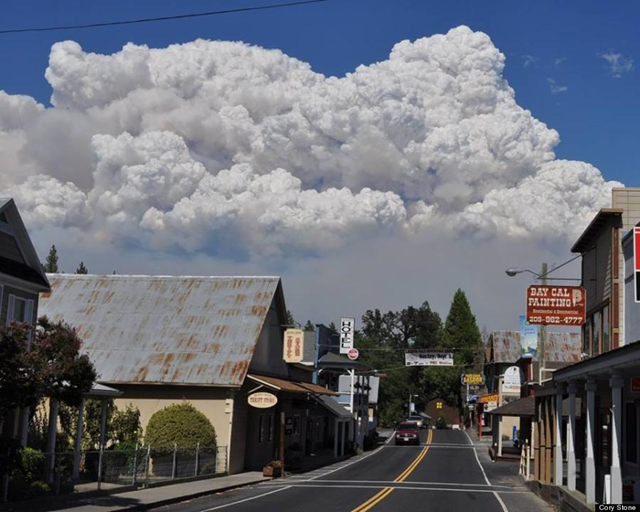
Smoke from the Yosemite Rim Fire rises over downtown Groveland, California, 28 August 2013. Photo: Cory Stone
Image of the Day: Smoke from the Rim fire rising over Groveland, California, 28 August 2013 — 
A sign above a desiccated river bed in California’s Central Valley reads, ‘Food Grows Where Water Flows’. The Central Valley—prime agricultural land—is being hit the hardest by the state-wide drought which could cause catastrophic losses to crops and food supply. Photo: Center for American Progress / EcoWatch
California enters third consecutive dry winter, statewide drought worst on record – ‘Lack of rain and snow this winter could bring catastrophic losses to California agriculture’ — 
A submerged statue of the Hindu Lord Shiva stands amid the flooded waters of river Ganges at Rishikesh in the Himalayan state of Uttarakhand, 17 June 2013. Early monsoon rains have swollen the Ganges, India’s longest river, swept away houses, killed at least 60 people and left tens of thousands stranded, officials said on 18 June 2013. Photo: REUTERS / Stringer
Indian monsoon flooding ‘leaves 1000 dead’ – ‘It was shocking to watch a place bustling with people metamorphose in a matter of a few hours into an island of death and destruction’ — 
Floodwaters from the Elbe River inundate a yard with a swimming pool near Magdeburg, Germany, on Monday, 10 June 2013. Photo: Thomas Peter / Reuters / Landov
Thousands more forced from home by record floods in Germany — 
A dead cow is lifted from flooding in the aftermath of winter storm Atlas in South Dakota, 13 October 2013. Photo: Lacey Weiss
South Dakota cattle cataclysm: Why isn’t this horror news? — 

NASA’s Aqua satellite acquired this false-color image of the swollen Amur River at record flood levels, on 8 September 2013. The extreme floods in northeastern China and the Russian Far East inundated Komsomolsk-on-Amur, a Russian city of about 500,000 people. The floods farther downstream in China affected more than 5 million people. Photo: NASA GSFC
Image of the Day: Satellite view of record floods inundating Russia’s Far East, 8 September 2013 — 
A storm surge caused by extreme storm Xaver hits Port of Dagebuell in Northern Germany, 5 December 2013. Photo: CARSTEN REHDER / AFP
Hurricane Xaver batters Scotland as Germany braces for storm – Authorities warn of ‘most serious coastal tidal surge for over 60 years in England’ — 
Satellite view of Super Typhoon Haiyan approaching the Philippines on Thursday, 7 November 2013. Photo: EUMETSAT
Video filmed by an aid worker shows the storm surge caused by Typhoon Haiyan on 8 November 2013, with two big waves hitting Hernani town in the Philippines. He, along with five others, took refuge in the top floor of a boarding house and said that while the others were praying he pulled out his camera and started filming.
Video: Storm surge as Typhoon Haiyan makes landfall — 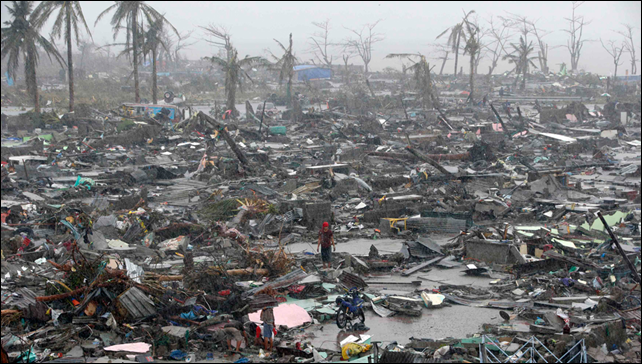
Survivors stand among debris and ruins of houses destroyed after Super Typhoon Haiyan battered Tacloban city in central Philippines, 10 November 2013. Photo: Erik De Castro / Reuters
Philippines typhoon survivors desperate for clean water – ‘Forgotten’ survivors tell of hunt for food – Grounded barge spills 1.2 million liters of oil into bay — 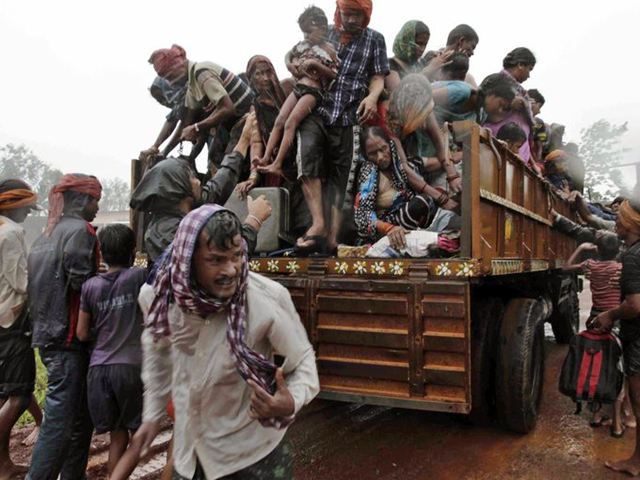
Evacuated Indian villagers get down from a truck at a relief camp as it rains near Berhampur, India, on 12 October 2013. Hundreds of thousands of people living along India’s eastern coastline were taking shelter Saturday from a massive, powerful cyclone, dubbed Phailin, that was set to reach land packing destructive winds and heavy rains. Photo: Bikas Das / AP
Cyclone Phailin battering India, turns deadly – 600,000 people evacuated, 12 million people likely to be affected — 
This photo taken Monday, 17 June 2013, shows people sunning at Goose Lake in Anchorage, Alaska. Parts of Alaska are setting high temperature records as a heat wave continues across Alaska. Temperatures are nothing like what Phoenix or Las Vegas gets, but temperatures in the 80s and 90s are hot for Alaska, where few buildings have air conditioning. Photo: Mark Thiessen / AP Photo
Baked Alaska: Unusual heat wave hits 49th state – ‘I’ve never seen a summer like this, ever’ — 
On 17 June 2013, NASA’s Terra satellite acquired this rare, nearly cloud-free view of the state of Alaska. The same ridge of high pressure that cleared Alaska’s skies also brought stifling temperatures to many areas accustomed to chilly June days. Talkeetna, a town about 100 miles north of Anchorage, saw temperatures reach 96°F (36°C) on 17 June 2013. Other towns in southern Alaska set all-time record highs, including Cordova, Valez, and Seward. The high temperatures also helped fuel wildfires and hastened the breakup of sea ice in the Chukchi Sea. Photo: Jeff Schmaltz / NASA
Why NASA’s latest photo of Alaska is freaking people out — 
Norilsk – above the Arctic Circle – is known as one of the world’s coldest cites, and is built on permafrost. This sunbathing picture was taken around Lake Baikal on 24 July 2013. Photo: The Siberian Times
Siberia breaks records for Arctic heat – ‘I’ve never worn a bikini before in Norilsk’ — 
The Visible Infrared Imaging Radiometer Suite (VIIRS) on the Suomi NPP satellite captured this view of extensive sea-ice fracturing off the northern coast of Alaska. The event began in late-January and spread west toward Banks Island throughout February and March 2013. Photo: NASA Earth Observatory
Image of the Day: Satellite view of extensive ice fractures in the Beaufort Sea — 
Pine Island Glacier, 8 July 2013. On the left-hand side the newly formed iceberg, 720 square kilometres in area, is visible. Photo: DLR
Iceberg bigger than Chicago breaks off Antarctica glacier — 
Found in Svalbard in 2013, this 16-year-old male polar bear died of starvation resulting from the lack of ice on which to hunt seals. Photo: Ashley Cooper / Global Warming Images
Starved polar bear perished due to record sea-ice melt, says expert – ‘He had no external suggestion of any remaining fat, having been reduced to little more than skin and bone’ — 
This 27 September 2013 image provided by NOAA Fisheries shows thousands of walruses hauling out on a remote barrier island in the Chukchi Sea near Point Lay, Alaska. An estimated 10,000 Pacific walrus have gone ashore on Alaska’s northwest coast and are bunched along a beach near the village of Point Lay. The National Marine Fisheries Service says 1,500 to 4,000 walrus were counted Sept. 12 and numbers had swollen to 10,000 on Friday, 27 September 2013. Photo: Stan Churches / NOAA Fisheries
With no sea ice to live on, 10,000 walrus come ashore in northwest Alaska — 
Beachgoers in China walk by an algae-covered public beach in Qingdao, China, in July 2013. The seas off China have been hit by their largest-ever growth of algae, ocean officials say, with waves of green growth washing onto the shores. Photo: AFP / Getty Images
Algae proliferation costs are ‘in the billions’ – ‘By fertilizing the planet, we end up fertilizing everything’ — 
Late summer plankton bloom covers Lake Ontario, one of North America’s Great Lakes. Microscopic cyanobacteria, or blue-green algae, have reached such large concentrations and color the water to such an extent that the change is visible from orbit. Photo: ISS Expedition 36 crew / NASA
Image of the Day: Satellite view of algae bloom on Lake Ontario, 24 August 2013 — 
The waters of Lake Erie seem to glow green in this image taken by the Moderate Resolution Imaging Spectroradiometer (MODIS) on NASA’s Aqua satellite on 26 September 2013. The color comes from a toxic algae bloom, which has been growing in the lake since mid July. Photo: LANCE/EOSDIS MODIS Rapid Response Team at NASA GSFC
Image of the Day: Satellite view of toxic algae bloom in Lake Erie, 26 September 2013 — 
Smoke rises from railway cars that were carrying crude oil after derailing in downtown Lac Mégantic, Quebec, Saturday, 6 July 2013. Photo: Paul Chiasson / THE CANADIAN PRESS
Photo gallery: Oil train explosion in Quebec town of Lac Mégantic – ‘Everything that was there is gone’ — 
10 January 2013 (Ceres.org) – Nighttime satellite view of North Dakota gas flares. In North Dakota’s Bakken shale region, widespread flaring across millions of acres lights up the night sky, burning off enough energy each day to heat half a million homes. Flaring is also prevalent in other key shale regions, like Texas’s Eagle Ford. Excessive flaring of natural gas affects regional air quality and creates significant greenhouse gas emissions that investors are seeking to reduce. Photo: NASA Earth Observatory / NOAA NCDC via Ceres.org
Image of the Day: Nighttime satellite view of North Dakota gas flares — 
A 6 June 2013 photo provided by a government scientist shows the site of an oil spill in Cold Lake, Alberta. The company that runs the operation says it is effectively managing the cleanup. Photo: The Star
Alberta oil sands spills have been going on for weeks with no end in sight – ‘This is a new kind of oil spill and there is no off button’ — 
Elephant Butte Reservoir dwindled to its lowest level in 41 years during the summer of 2013, despite monsoon rains in early July. It had been filled nearly to capacity for most of 1985 to 2000; the left-hand image from 1994 shows it about 89 percent full. At right, on 8 July 2013, it has been reduced to about 3 percent. Photo: NASA
Image of the Day: Satellite view of Elephant Butte Reservoir in New Mexico, 1994 and 2013 —
A montage of timelapse satellite views shows human destruction of the biosphere over three decades. From the Timeline project, assembled by TIME magazine.
Video: Timelapse satellite views of human destruction of the biosphere over three decades
Des, why don't images like this cause people to do something? There aren't even any comments posted!
I know the answer, so the question is rhetorical.
Humans don't care about anything but themselves. Everything is for sale. Everything can be exploited. Everything on Earth is here for our benefit.
This exactly the message taught by Christianity, the corporate world, business, Republicans, Democrats, and every institution in the West, and probably the East.
Take what you want. Try to make a profit if you can. That's what it's all about.
Depleting the world to extinction / collapse is religiously denied despite the factual evidence found everywhere.
Modern humans need to go. No species has the right to biocide.